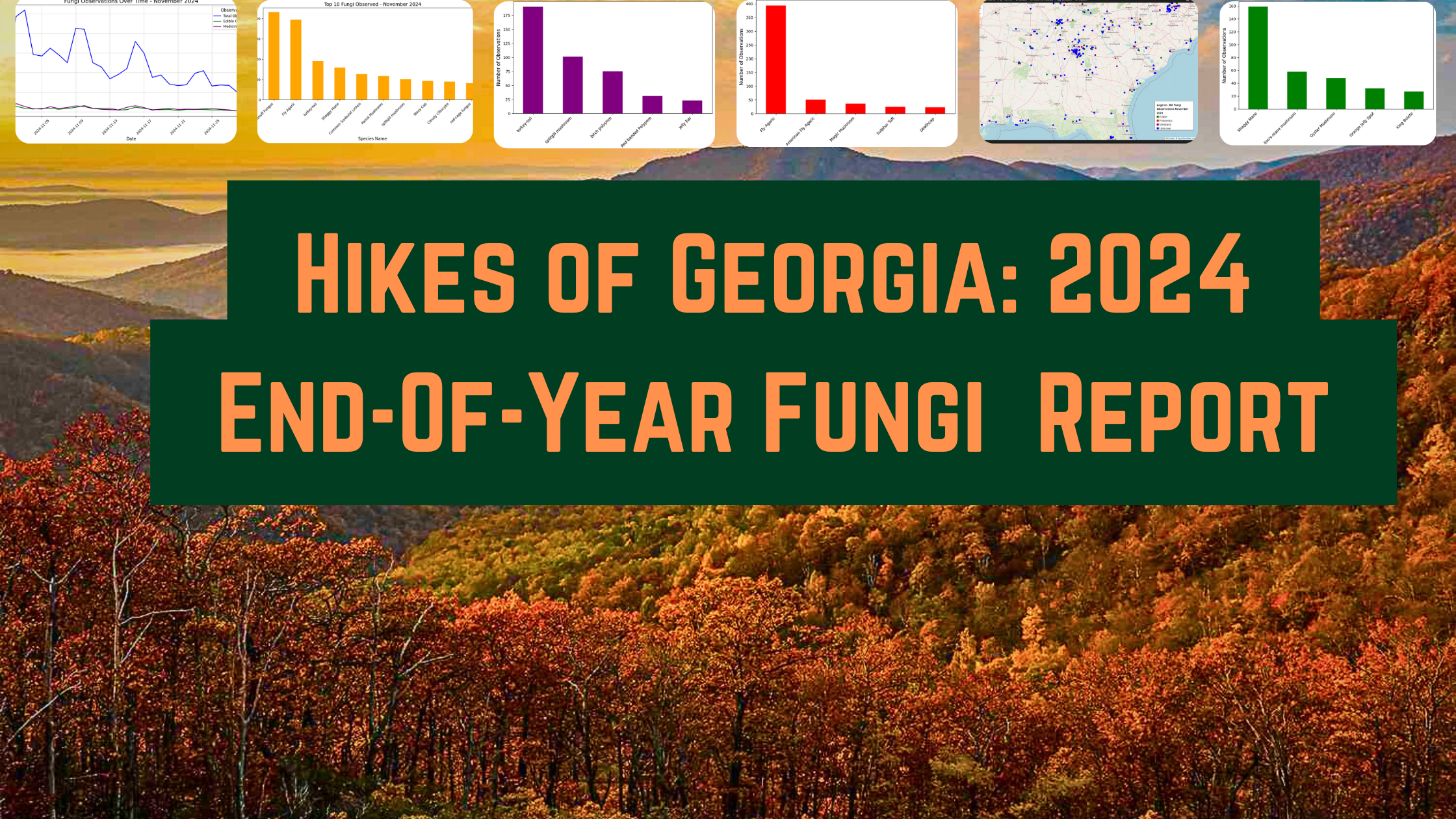Table of Contents
As the year 2024 draws to a close, Hikes of Georgia is thrilled to present our comprehensive End-of-Year Fungi Observation Report, a detailed exploration of the diverse fungi species found across Georgia. Leveraging data sourced from the iNaturalist database, this report highlights key insights, trends, and visualizations from over 37,000 recorded fungi observations. From edible and medicinal fungi to regional hotspots, our analysis underscores Georgia’s vibrant and diverse fungal ecosystem. Whether you’re a mycology enthusiast, nature lover, or beginner hiker, this report is your guide to understanding the fascinating world of fungi in Georgia. Dive in to discover the top observed species, seasonal trends, and much more!
Overview of the Report
- Report Timeframe: January 2024 – December 2024
- Dataset Source: iNaturalist.org
- Deliverables:
- Overall fungi observation trends
- Top 10 most observed fungi species
- Top 5 edible species
- Top 5 medicinal species
- Seasonal trends for edible and medicinal fungi
- Observation hotspots (regional breakdown)
- Observation edibility breakdown (medicinal, edible, unknown)
Overall Fungi Observation Trends
Visualization:

Analysis:
The total number of observations recorded in 2024 was 37,194, with 2,187 unique species identified. Among these, 26 species were categorized as edible and 19 as medicinal. This indicates that a large portion of observed fungi remains under the “unknown” category, highlighting the need for further research and classification in Georgia’s fungi ecosystem.
Monthly Trends in Fungi Observations
Visualization:

Analysis:
Observations peaked in July 2024, with a significant total of 6,411 observations, likely influenced by favorable summer weather conditions and increased outdoor activity. May also saw a spike in activity with 4,524 observations, attributed to springtime hikes and the resurgence of various fungi species. Observation levels dipped during late winter (February) and the late summer heat (August).
Edibility Breakdown
Visualization:

Analysis:
The pie chart illustrates that 92.3% of the fungi observations were classified as “unknown,” while 3.7% were categorized as edible and 4.0% as medicinal. This distribution emphasizes the untapped potential of Georgia’s fungi population for culinary and medicinal uses.
Top 10 Most Observed Fungi
Visualization:

Analysis:
The most observed fungi group was “Fungi Including Lichens,” with over 1,400 observations, followed by amanita mushrooms and brittlegills, both reaching over 1,000 observations each. These results showcase the diversity of Georgia’s fungi and the prominence of certain species in natural habitats.
Top 5 Edible Fungi Species
Visualization:

Analysis:
The lion’s mane mushroom was the most observed edible fungi species, with over 170 observations, followed by pale oyster mushrooms and red chanterelles. These fungi are not only widely found in Georgia’s ecosystems but are also popular in culinary applications.
Top 5 Medicinal Fungi Species
Visualization:

Analysis:
Turkey-tail mushrooms dominated the medicinal fungi category with over 600 observations, underlining their ecological and medicinal significance. Golden reishi and lion’s mane mushroom also emerged as key species, showcasing their dual role as both medicinal and edible fungi.
Seasonal Trends for Edible and Medicinal Fungi
Edible Fungi Seasonal Trends
Visualization:

Analysis:
Edible fungi species exhibited seasonal peaks, with lion’s mane mushrooms surging in November and December, likely tied to cooler weather and specific growth conditions. Other species such as red chanterelles were most active during spring and summer months.
Medicinal Fungi Seasonal Trends
Visualization:

Analysis:
Medicinal fungi showed a varied growth pattern, with turkey-tail mushrooms peaking in early spring and late fall. Golden reishi mushrooms saw a steady distribution throughout the year, reflecting their adaptability to Georgia’s changing climate conditions.
Observation Hotspots by Region
Visualization:

Analysis:
The top counties for fungi observations were DeKalb, Fulton, and Gwinnett, reflecting their larger populations and accessibility to natural hiking areas. Cobb and Clarke counties rounded out the list, showing the geographical spread of fungi research across the state.
Georgia Fungi Observation Map
The map above provides a detailed spatial visualization of fungi observations across Georgia for the year 2024. Each point on the map represents a specific observation, categorized by edibility status:
- Green: Edible fungi observations
- Purple: Medicinal fungi observations
- Blue: Unknown or uncategorized fungi observations
The map is interactive, allowing users to zoom in and out and explore specific areas of interest. This visualization offers a geographical perspective, highlighting observation hotspots and the distribution of different fungi types across the state.
Closing Summary
The 2024 End-of-Year Georgia Fungi Report highlights the incredible diversity and distribution of fungi across the state. With over 37,000 observations and 2,187 unique species, Georgia’s natural habitats continue to be a hotspot for mycological activity. This report not only celebrates the ecological importance of fungi but also serves as a call to action for further research into unexplored species and their potential applications.
Stay tuned for future monthly reports and join Hikes of Georgia for a firsthand exploration of these incredible organisms in 2025!

